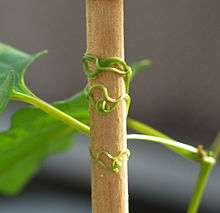Thigmotropism

Thigmotropism is a directional growth movement of curvature which occurs in response to stimulus of contact. Thigmotropism is found in twining plants and tendrils. After initial contact with support due to nutation, the tendril or twiner shows less growth in the region of contact and more growth on the opposite side. As a result, they bend around the support. Later on, bending or coiling may occur in untouched parts of the tendril as well. Thigmotropism is a movement in which a plant moves or grows in response to touch or contact stimuli. The prefix thigmo- comes from the Greek for "touch" (θιγμός). Usually thigmotropism occurs when plants grow around a surface, such as a wall, pot, or trellis. Touched cells produce auxin and transport it to untouched cells. Some untouched cells will then elongate faster so cell growth bends around the object.
Roots also rely on touch to navigate their way through the soil. Generally, roots have a negative touch response, meaning when they feel an object, they would grow away from the object. This allows the roots to go through the soil with minimum resistance. Because of this behavior, roots are said to be negatively thigmotropic. Thigmotropism seems to be able to override the strong gravitropic response of even primary roots. Charles Darwin performed experiments where he found that in a vertical bean root, a contact stimulus could divert the root away from the vertical.
Other kinds of tropisms include gravitropism, phototropism, hydrotropism, and heliotropism. Gravitropism is the principle of turning based on gravity. Phototropism is the principle of turning based on the source of the plant's light. Hydrotropism is when the plant's roots grows toward a source of water. Heliotropism is when a plant follows the sun throughout the day. The helianthus (sunflower) is a plant that uses heliotropism.
Other kinds of plant movement
Mimosa pudica is well known for its rapid plant movement. The leaves close up and droop when touched. However, this is not a form of tropism, but a nastic movement, a similar phenomenon. The difference is that tropisms are influenced by the direction of their stimulus, while nastic movements are not.